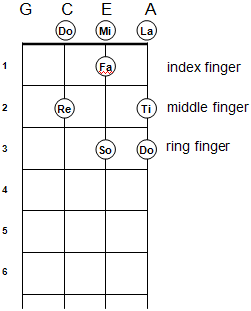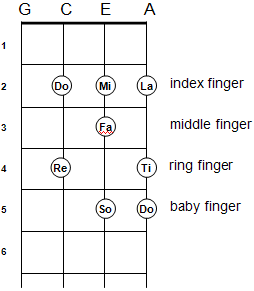 Let's look at how to play scales on the ukulele. Why? Well... The easy answer is that, like eating your vegetables, it's good for you. But there are also more substantial reasons. As you learn to compose and play solos, you'll need to be able to play scales effortlessly. Also, scales are an important part of playing leads and improvisation. And they're good just as drills to improve your speed and dexterity on the uke. Lots more reasons, but let's move on to actually learning something. We're assuming some basic level of understanding of music theory here (not very much though, so don't run away yet!) Hopefully, you know what a scale is, and that scales exist for each key. And you should know that the intervals between notes are not equal as you go up the scale: sometimes it's a half step between notes and sometimes it's a full step (two half steps). You might want to check out this page to make sure we're using the same terminology. We're not going to go into more exotic modes (if you don't know what a mode is, don't worry – we're not going there in this tutorial), we're just going to show you how to play major scales, with a brief paragraph at the end to talk a little about minor scales. The first scale to learn is the C major scale. Let's look at it
in a few different ways. Here's the scale as shown in conventional
musical notation:
 Here are the notes of the C scale on a piano keyboard. Notice that the intervals E-to-F and B-to-C are half steps (there are no flats or sharps between the notes), and the others are full steps. You'll need to know this to play scales on the uke: to raise a note by a half step you go up one fret on the uke, to raise a note by a full step you go up two frets.  Now, there are many ways to play a scale on the ukulele. You can play all of the notes on one string, going up one fret or two frets as appropriate for each note. But this isn't the most practical way to play a scale. It's cumbersome and slow, and you can't always fit the whole scale on one string without running out of frets. Better to use more than one string. Here's the most practical way to play the C scale on a ukulele.
(Here, you're playing only one string at a time – not chords. The
first two notes are played on the C string, the next three notes are played
on the E string, and the last three notes are played on the A string.
The notation "o" above a string means to play that string open – unfretted.)
 Now you may have noticed that the fifth note ("So", a G) is played on the E string third fret rather than the open G string. Either way, you're playing a G, so why aren't we using the open string? Well, there are a couple of reasons. One reason is that some people set up their ukuleles with a low G string, so if you played the "So" note on the G string, it would be an octave too low. Another reason is that you can play a scale faster and more evenly if you don't have to jump back and forth between strings quite so much. One more reason: As you'll see in a moment, we will be creating patterns for playing scales, patterns that you can then shift up the fretboard to play scales in other keys. As you shift these patterns up the fretboard, you'll no longer be playing an open G string, so the advantage of an open string for that note exists only in the case of the C scale. Here's that C major scale shown all at once on the fretboard:
 Pay attention to which fingers to use in playing the scale. Of course, the scale will sound the same no matter which fingers you use, but it's a good idea to use a consistent and logical pattern. It'll help as you pick up the speed of your playing. Now, if you move that same pattern somewhere else on the fretboard,
you'll still be playing a major scale, just in a different key. For
example, if you move it up two frets (moving "up" the fretboard moves you
to a higher pitch, even though it is shown as moving down on the diagram),
you'll be playing a D major scale (if it's not clear to you why moving
up two frets makes this a D scale, you might want to check out All
The Notes On All The Strings ).
 Notice that the fingering is different, since you can no longer use the nut (the nut is that slotted string guide between the fretboard and the tuning pegs) to provide you with some of the notes. So the C scale is really a special case, its fingering is unique. All of the other scales (C#, D, D#, E, etc.) are fingered like you see in the example of the D scale. Again, learn to use this fingering pattern. While it's tempting at first to avoid using your baby finger (little finger, pinkie, whatever...) because it isn't as strong or as agile as your other fingers, you'll be a better player if you learn to use it.
|